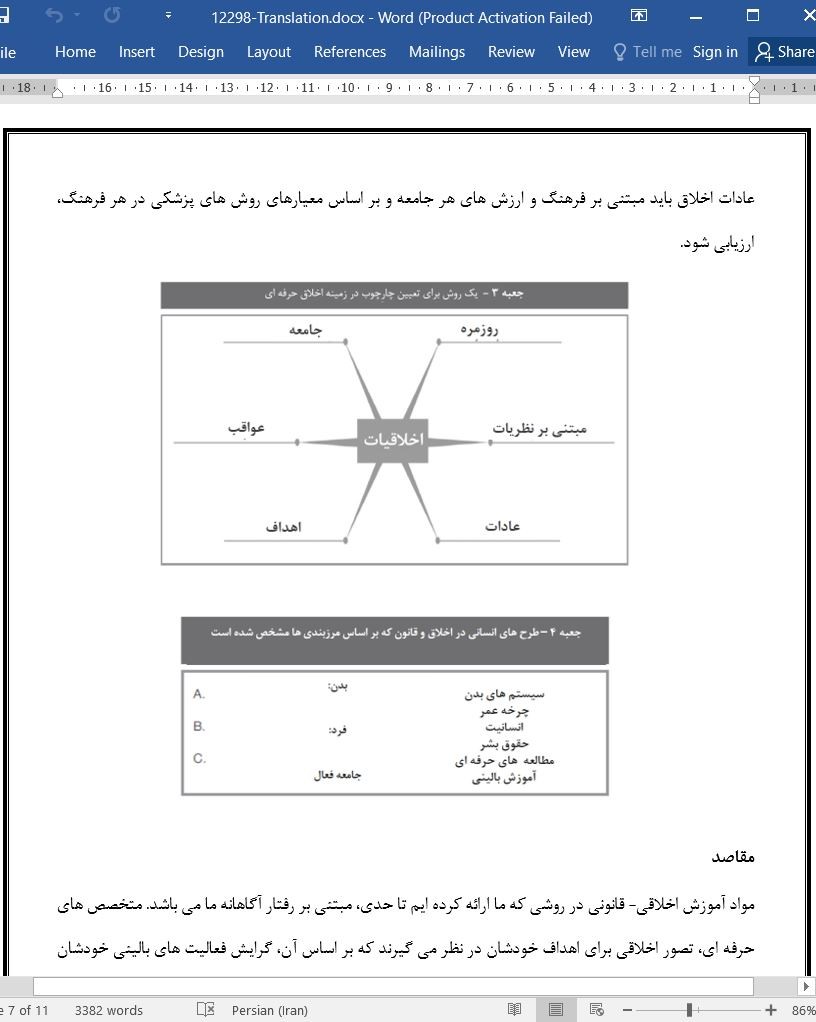
درک اخلاق و قانون در آموزش پزشکی
چکیده
لحظه ای که بیمار وارد اتاق درمان می شود، متخصص پزشکی در یک زمینه اخلاقی و قانونی باید خدمات خودش را ارائه کند. وظیفه مدرس های پزشکی، این است که دانشجویان خودشان را برای این حقیقت بالینی به صورتی مجهز کنند که هم برای دانشجویان و هم برای انواع مدرس های پزشکی در دانشکده ها و به صورت کلی برای تمام کسانی که قرار است تفسیر خودشان را از این حوزه علمی داشته باشند، قابل درک باشد.
اخلاق و قانون در آموزش های پزشکی (Dowie and Martin 2011)، هدفش ارائه کردن درک چگونگی استفاده از اخلاق و قانون در آموزش ها به صورت ساختار یافته، یکپارچه و منطقی می باشد.
ما باید باید نخست دیدگاه اولیه دوره خودمان را بررسی کنیم و دامنه کلی یادگیری را شناسایی کنیم که قانون و اخلاق با آن ارتباط دارد. به جای ارائه کردن موضوعات اخلاقی- قانونی متنوع به دانشجویان، یادگیری آن ها را می توان با ایجاد کردن یک چارچوب با تاکید مشخص بر روی قانون و اخلاق، تقویت کرد. یک چارچوب اخلاق حرفه ای در این قسمت ارائه شده است که تمام المان های روزمره، نظری، عادات، هدف ها، عواقب و موضوعات اجتماعی مرتبط با این رویکرد را بررسی می کند.
این دوره همچنین باید در یک دوره آموزشی گسترده تر ارائه شود و این کار، باعث می شود که این دوره بتواند از یک فرآیند یکپارچه و به هم مرتبط بهره ببرد که به صورت مستقیم برای دانشجویان در زمینه تحصیلی دانشکده های پزشکی، معنی داشته باشد. در نهایت، در این رهنمود، نمونه هایی از طرح های انسان دوستانه ارائه می شود که تمرکزشان بر روی مرز های موجود در خدمات درمانی، بدن انسان، فرد و جامعه با یک رویکرد عملی می باشد.
خلاصه
درک اخلاق و قانون در دوره های آموزشی با شفاف سازی اهداف دوره ها در ترکیب با حوزه کلی یادگیری در زمینه مربوطه، محقق می شود. این موضوع، با ساختار چارچوب های مرتبط بر اساس اصول کلیدی، تقویت می شود. این دوره همچنین باید در یک برنامه آموزشی گسترده ارائه شود و از دوره های یکپارچه و به هم مرتبط بهره ببرد که به صورت مستقیم، در تنظیمات آموزش های پزشکی در دانشگاه ها مطابقت داشته باشد.
Abstract
The moment a patient comes into the treatment room, the medical professional is placed in both an ethical and a legal context. The task for medical teachers is to equip students for this clinical reality in a way that makes sense both to the learners and to the variety of medical educators in the school, all of whom will have their own interpretations of the nature of this subject area.
Ethics and law in the medical curriculum (Dowie and Martin 2011), aims to provide an understanding of how ethics and law can be incorporated into the curriculum in a structured, coherent, and logical manner.
It is essential that we begin with a vision of the primary purpose of our course, and clarify the overall domain of learning to which it relates. Rather than presenting students with a miscellany of ethico-legal topics, their learning can be reinforced by constructing a frame around the key emphases in law and ethics. A professional ethics frame is proposed, highlighting the everyday, theorybased, habits, intentions, consequences and society elements of this approach.
The course also has to be mediated within the wider curriculum, and this benefits from a coherent and communicated course scheme that is directly meaningful within the educational setting of the medical school. Finally, within the Guide, examples of humanistic schemes are presented that centre on aspects of boundary in patient care, themed around body, person and community of practice.
Summary
Making sense of ethics and law in the curriculum begins with clarifying the purpose of the course in conjunction with the overall domain of learning to which it relates. This is reinforced by constructing a relevant frame around its key emphases. The course also has to be mediated within the wider curriculum, and benefits from a coherent and communicated course scheme that is directly meaningful within the educational setting of the medical school.
چکیده
مقدمه
شفاف سازی ماهیت و هدف یادگیری اخلاقی- قانونی
ایجاد کردن یک چارچوب برای اخلاقیات و قانون در آموزش های پزشکی
روزمره
مبتنی بر نظریات
عادات
مقاصد
عواقب
جامعه
قرار دادن اخلاق و قانون در یک بستر آموزشی
بدن
فرد
جامعه فعال و دست اندرکار
خلاصه
منابع
Abstract
Introduction
Clarifying the nature and purpose of ethico-legal learning
Constructing a frame for ethics and law in the curriculum
Everyday
Theory-based
Habits
Intentions
Consequences
Society
Mediating ethics and law in the curriculum
Body
Person
Community of practice
Summary
References
- اصل مقاله انگلیسی با فرمت ورد (word) با قابلیت ویرایش
- ترجمه فارسی مقاله با فرمت ورد (word) با قابلیت ویرایش، بدون آرم سایت ای ترجمه
- ترجمه فارسی مقاله با فرمت pdf، بدون آرم سایت ای ترجمه



